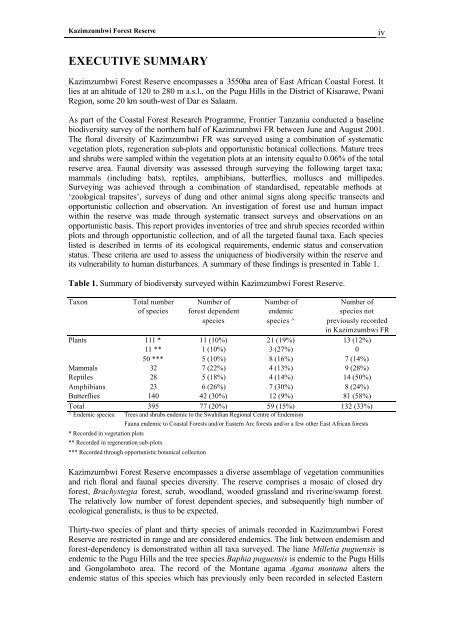Frontier Tanzania Environmental Research REPORT 110 ...
Frontier Tanzania Environmental Research REPORT 110 ...
Frontier Tanzania Environmental Research REPORT 110 ...
You also want an ePaper? Increase the reach of your titles
YUMPU automatically turns print PDFs into web optimized ePapers that Google loves.
Kazimzumbwi Forest Reserve<br />
iv<br />
EXECUTIVE SUMMARY<br />
Kazimzumbwi Forest Reserve encompasses a 3550ha area of East African Coastal Forest. It<br />
lies at an altitude of 120 to 280 m a.s.l., on the Pugu Hills in the District of Kisarawe, Pwani<br />
Region, some 20 km south-west of Dar es Salaam.<br />
As part of the Coastal Forest <strong>Research</strong> Programme, <strong>Frontier</strong> <strong>Tanzania</strong> conducted a baseline<br />
biodiversity survey of the northern half of Kazimzumbwi FR between June and August 2001.<br />
The floral diversity of Kazimzumbwi FR was surveyed using a combination of systematic<br />
vegetation plots, regeneration sub-plots and opportunistic botanical collections. Mature trees<br />
and shrubs were sampled within the vegetation plots at an intensity equal to 0.06% of the total<br />
reserve area. Faunal diversity was assessed through surveying the following target taxa;<br />
mammals (including bats), reptiles, amphibians, butterflies, molluscs and millipedes.<br />
Surveying was achieved through a combination of standardised, repeatable methods at<br />
‘zoological trapsites’, surveys of dung and other animal signs along specific transects and<br />
opportunistic collection and observation. An investigation of forest use and human impact<br />
within the reserve was made through systematic transect surveys and observations on an<br />
opportunistic basis. This report provides inventories of tree and shrub species recorded within<br />
plots and through opportunistic collection, and of all the targeted faunal taxa. Each species<br />
listed is described in terms of its ecological requirements, endemic status and conservation<br />
status. These criteria are used to assess the uniqueness of biodiversity within the reserve and<br />
its vulnerability to human disturbances. A summary of these findings is presented in Table 1.<br />
Table 1. Summary of biodiversity surveyed within Kazimzumbwi Forest Reserve.<br />
Taxon Total number Number of Number of Number of<br />
of species forest dependent endemic species not<br />
species species ^ previously recorded<br />
in Kazimzumbwi FR<br />
Plants 111 * 11 (10%) 21 (19%) 13 (12%)<br />
11 ** 1 (10%) 3 (27%) 0<br />
50 *** 5 (10%) 8 (16%) 7 (14%)<br />
Mammals 32 7 (22%) 4 (13%) 9 (28%)<br />
Reptiles 28 5 (18%) 4 (14%) 14 (50%)<br />
Amphibians 23 6 (26%) 7 (30%) 8 (24%)<br />
Butterflies 140 42 (30%) 12 (9%) 81 (58%)<br />
Total 395 77 (20%) 59 (15%) 132 (33%)<br />
^ Endemic species: Trees and shrubs endemic to the Swahilian Regional Centre of Endemism<br />
Fauna endemic to Coastal Forests and/or Eastern Arc forests and/or a few other East African forests<br />
* Recorded in vegetation plots<br />
** Recorded in regeneration sub-plots<br />
*** Recorded through opportunistic botanical collection<br />
Kazimzumbwi Forest Reserve encompasses a diverse assemblage of vegetation communities<br />
and rich floral and faunal species diversity. The reserve comprises a mosaic of closed dry<br />
forest, Brachystegia forest, scrub, woodland, wooded grassland and riverine/swamp forest.<br />
The relatively low number of forest dependent species, and subsequently high number of<br />
ecological generalists, is thus to be expected.<br />
Thirty-two species of plant and thirty species of animals recorded in Kazimzumbwi Forest<br />
Reserve are restricted in range and are considered endemics. The link between endemism and<br />
forest-dependency is demonstrated within all taxa surveyed. The liane Milletia puguensis is<br />
endemic to the Pugu Hills and the tree species Baphia puguensis is endemic to the Pugu Hills<br />
and Gongolamboto area. The record of the Montane agama Agama montana alters the<br />
endemic status of this species which has previously only been recorded in selected Eastern

















